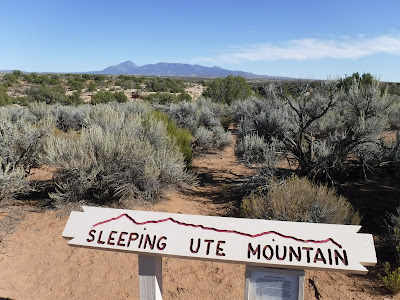Thursday, September 28, 2017 was our last full day in Blanding, in southeast Utah near the Four Corners. We've spent the last week driving all over this area. There is so much here to explore. When we checked into our campground last week, the owner told us that there are ruins just a mile and a half away. We decided it would make a great last day adventure. We could go out in the morning and explore and still have time to do our pre-move chores. Right after breakfast, we jumped on our bikes for the mile and a half ride to the trailhead. Along the way, we passed an overlook for Nations Natural Bridge - so named because it is on tribal land.
We thought about climbing down to explore further, but the trail was rather steep. From our vantage point on the canyon rim we could see across to the opening in the natural bridge. We could also hear Westwater Creek burbling below. It might be possible to get to the bridge from the other side of the canyon, and we have since found that a dirt road follows the western canyon rim behind the bridge, but - again - we've run out of time to explore further. So we had to satisfy ourselves with this view of the bridge from the eastern rim of Westwater Canyon:
The road continued for another half mile before ending in a large parking area. The trailhead was marked, "Five Kiva Pueblo." We parked our bikes and started to scout our route to visit the ruins:
We could only assume, from the name, that the large pueblo across the canyon contained five kivas. However, we wanted to be sure, so we locked the bikes to the trailhead sign and began to work our way down into the canyon.
The trail was not marked but it was fairly easy to follow. At one point, Kathy tripped over a rock and discovered this large arrow shaped object, which might be a spearhead or a scraper. After taking this picture, we carefully put it back, noted the GPS coordinates, and, when we returned to camp, filed a report with Utah State Parks' archaeologist.
Before we left on our adventure, we tried to find information about the site. The Blanding Visitor Center Map refers to it as the Westwater Ruin. We searched both Five Kiva Pueblo and Westwater Ruin. We found one reference to Westwater Ruins - a cliff dwelling that was occupied about 1150 A.D. to 1275 A.D.
This area has been pretty much overlooked by the scientists. Due to its close proximity to Blanding, the pueblo buildings were pretty much picked clean. Over the years, people took many precious artifacts illegally. What was left was spray painted by the kids that like to come and party here.
You will be happy to know that we did, in fact, count five kivas.
This one is by far the largest and most intact.
It's hard to tell exactly how many families lived here. It was probably used as a central gathering place. From this vantage point, we could see a number of family pueblo units up and down the canyon. We decided to head off and explore a few of the other building areas.
This little two room unit was located down one level and to the north of the main pueblo on the east side of the canyon.
We noticed this rock art painting. We can only speculate that it was a clan symbol. We did look for more rock art and petroglyphs, but the walls have been pretty much carved up and spray painted by the vandals.
Just above the two room unit was a studio apartment with a great view down the canyon.
We noticed another set of buildings back across the canyon, high on the cliff wall. We bushwacked our way down to the stream bed, hopped across, and worked our way up to the main housing level.
Once inside, we could see several rooms.
Some of the walls even had their original plaster.
It's hard to say if that was an original window or was an addition made by some later squatter or visitor.
From each site we visited, we could look up or down the canyon and see another site that was probably occupied. On our way back out of the canyon, we noticed yet another complex. In fact, we probably passed the trail to this on our way to the Five Kiva Pueblo.
This was definitely a two story housing complex.
There were loads of storage spaces.
This retaining wall may have even held water from a seep under the rock ledge.
Wow. We came expecting to find one ruin, and we ended up finding a half dozen. It is hard to imagine how this vast empty desert once housed thousands of people all living and working together in their little canyon communities.
We're moving south tomorrow. There are two more areas we want to see before heading down to Albuquerque: Monument Valley (more rocks) and Canyon de Chelly (more ruins). So, stay turned.

























































